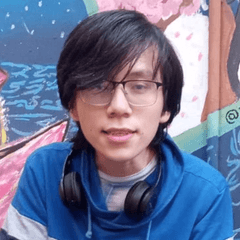3. Rough Coloring
I’ve finished the base painting, so now I’ll start adding color.
[1] Using blending modes while coloring
I create a new layer above the black-and-white base painting and set the blending mode to [Multiply].
I roughly paint the colors using my “No color mixing (circle)” brush on this [Multiply] layer.
At this stage, I will paint flat colors such as the skin color and hair color without thinking about where the light hits.
I decide the colors of some parts in advance, but I try a few different colors for parts such as the t-shirt to get a good balance with the other elements.
After I’ve finished the first colors, I create another layer on top set to [Overlay] and paint the highlights on the characters and the table.
It was too bright at 100% opacity, so I reduce it to 56%.
To brighten up the area around the legs, I create another layer on top set to [Soft light] and use the [Gradient] tool > [Foreground to transparent] to draw a pale yellow gradient from the bottom to the top of the canvas.
Once I’ve brightened up the whole illustration, I create another [Overlay] layer on top and paint in detailed highlights on the food and the characters’ eyes.
[2] Storing in a layer folder
I’ve increased the number of layers, so I move them to a layer folder.
When I move the layers into a folder, I change the layer folder’s blending mode to [Through] so that the blending modes affect layers outside of the folder.
Note: If the blending mode of the layer folder is [Normal], the layer blending modes only affect other layers inside the folder. When the folder’s blending mode is changed to [Through], the blending modes also apply to the layers beneath the folder, so the base painting becomes visible again.
At this point, I have five layers: “Base painting”, “Multiply”, “Overlay”, “Soft light”, and “Overlay” as shown below.
Now I’ve mostly finished adding the color.
























Comment